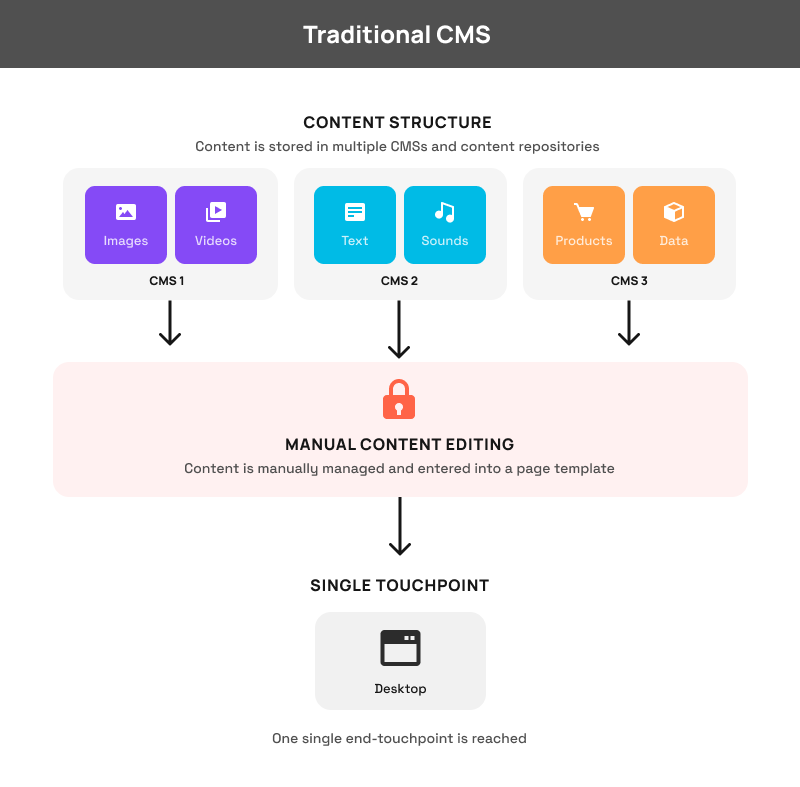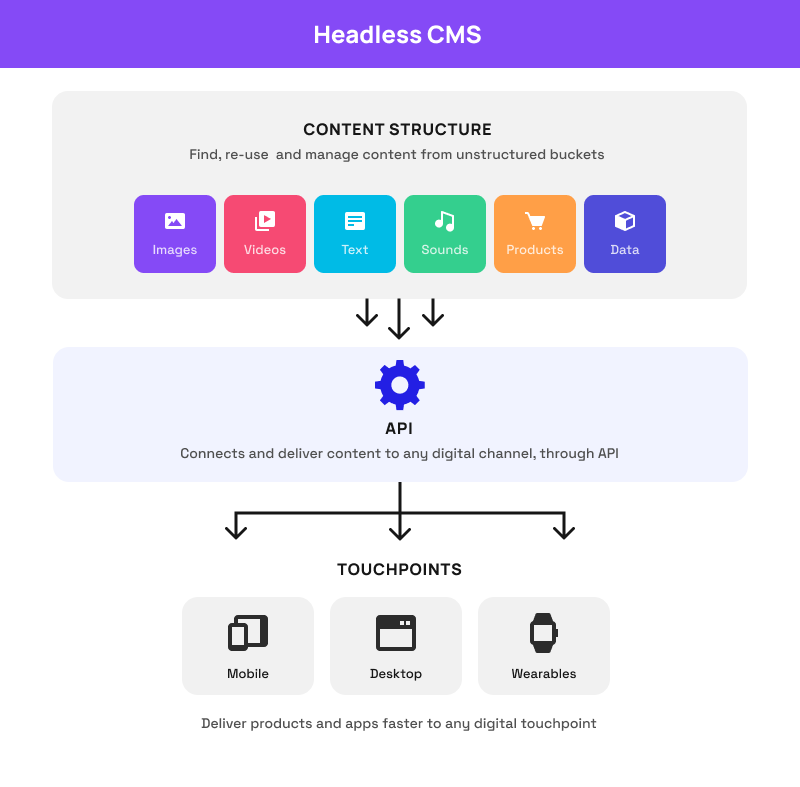Companies are looking for flexibility and increased productivity in every area of their business. This goes the same for the CMS architecture.
While a traditional or monolithic CMS platform was the standard way to go for web development, businesses started to shift towards a headless CMS solution.
If you're not sure yet if a headless CMS is the right option for you, we'll get into details about what a content management system is and the difference between traditional and headless CMS, with a focus on the latter.
But first things first.
Start building dynamic websites
Connect your Teleport project with a Headless CMS like Strapi, Contentful, Caisy, Flotiq or Wordpress. Manage the frontend visually with Teleport, using dynamic data from a CMS.
Build your first dynamic websiteWhat Is a CMS System?
A content management system, also known as a CMS system, is a software that helps users create and edit the content on a website through an intuitive interface that can be used by anyone, regardless of their technical knowledge.
In other words, a CMS system allows you to build a website without any coding skills.
Now that we talked about what a content management system is, let’s move on to the headless content management system definition.
What Is a Headless CMS System?
A headless CMS is a type of content management system that separates the backend, where the content is stored, from its presentation interface. This means that the body (backend) is separated from the head (the presentation layer).
A headless CMS is an API-first content platform, which means you can store your content in one place, but you can deploy it on any frontend you like, as it will deliver it via APIs.
This is truly helpful and effortless when you want to tackle omnichannel strategies.
How Does a Headless CMS work?
So, how is the headless CMS architecture made so it can give you such flexibility?
A headless CMS platform is usually offered as a Software as a Service (SaaS). This means you don’t have to install anything to use it. You just log into a web application that has its APIs stored in a backend cloud.
To have a clear view of this, we should also talk about APIs and the way they work with headless content management systems.
An API is a link between two applications that facilitates data exchange. The content that is stored in a headless CMS is delivered through APIs to any website or device.
This approach turns content into something adaptable, making it able to appear on every digital touchpoint.
A headless CMS architecture is different from a traditional one, such as WordPress or other monolithic CMSes. These have their frontend and backend connected and can't work one without the other. It's the only way your content can be displayed.
But more on this in a moment.
A headless CMS stores and manages your content, and it doesn't get affected by the frontend you wish your content to appear on. It goes the same for display platforms where your content is presented. They don't get influenced or affected by where the content is stored.
The connection between backend systems (headless CMS in this case) and frontend systems (websites) is made through the APIs.
Headless CMS vs. Traditional CMS
So you got the gist of how a headless website works. But we should compare a headless content distribution with traditional CMSes to have the entire picture.
A traditional CMS, also called monolithic, works based on functionalities that allow you to manage your content on a single system.
It only has one context for presenting the content, and it’s usually a web page. So you won’t have the flexibility a headless CMS gives you, and it’s going to be difficult to be present in more than one place with the same content.
A headless CMS framework is API first, which can help you make your content displayed more flexibly.

Traditional CMS:
- One context for displaying the content;
- Monolithic;
- Has limited device compatibility;
- Has to be managed by developers;
- Loads slower;
- Has longer iteration cycles.
Headless CMS:
- Supports omnichannel content distribution;
- Is modular;
- Is responsive to any website or device;
- The engineering part is already managed;
- Faster load times;
- Has rapid iteration cycles.

What Is the Difference Between Headless CMS vs. Decoupled CMS?
You’re probably wondering now what is the meaning of decoupled CMS and if it’s the same as a headless CMS.
Some use the terms interchangeably, but there’s a difference between them.
A decoupled CMS has, too, the backend separated from the frontend. The distinctive aspect is that a decoupled CMS comes with a head, but it’s up to you if you choose to use it.
Another difference is that traditional CMS platforms have APIs built on top of their monolithic systems and make them decoupled.
Although this seems like a plus for flexibility in rendering the content, the decoupled CMS still has traces of functionalities built for a single website, restricting the places where you can display your content.
A headless CMS doesn't have a presentation layer at all, and developers are the ones that choose how to display the content through interactive JSON frameworks or static site generators like TeleportHQ, for example.
Structured Content and the Headless CMS
A headless CMS works properly only if it works based on structured content. This is the only way APIs can deliver the same content across different websites and devices.
This means it’s highly essential you think about your content architecture. In other words, you have to break down your content into small building blocks, classified with metadata.
A structured content architecture separates all your page’s elements, such as title, image, copy, pricing, and others, into different components. This approach makes it easier to regroup them in the same order but adapted to a specific device, audience, or even marketing campaign.
The Benefits of a Headless CMS
As you probably have figured out already, there are quite a few advantages when it comes to a headless CMS.
So let’s see how a headless content management system will improve your work.
- Create and edit multi-channel content
With structured content and a headless CMS, you can create, distribute and make changes seamlessly. Because a headless content management system centralizes your data in one place but is able to showcase it on any digital touchpoint, anytime you'll change something, it will update everywhere.
With a headless content management system, you can find your audience across multiple channels, including different apps and websites.
- Fosters dynamic collaboration
Among the benefits of a headless CMS is the separation of the frontend from the backend, which allows developers and content editors to work at the same time without interfering with each other's progress.
Of course, for this, it is important to have that structured content we previously talked about.
- Increases scalability
With headless web development, you can display your content on any website or device, which makes your content easily reusable and scalable. It also allows developers to change their tools at any time.
Your content will be cloud-based, so the distribution from there to your users’ devices is fast and easy.
You can even personalize the content based on demographics and different campaigns to make it more relevant to your audience.
- Developers can choose according to preferences
Among the advantages of a headless CMS is the distribution through APIs, which allows developers to choose their preferred frontend programming language and tooling. They can also move from one framework to another without interfering with the CMS.
- Enables faster editing
The headless CMS options include advantages when editing your content because you don’t have to worry about the rendering side. A traditional CMS architecture, on the other hand, requires more resources on your part, even when it comes to delivering your content.
Conclusion
Once you get the true meaning of a headless CMS, you understand that your valuable content can get in front of many people, across multiple channels, all at the same time and with minimal effort.
Headless content management systems have many benefits, and while you'll surely appreciate all of them, the increased productivity and reach of your target audience are going to shape all the reasons why any business should use headless CMS.



